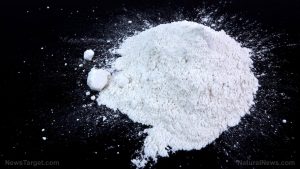
Dichlofluanid – toxicity, side effects, diseases and environmental impacts
Thursday, November 23, 2017 by Rita Winters
http://www.naturalpedia.com/dichlofluanid-toxicity-side-effects-diseases-and-environmental-impacts.html

Dichlofluanid is a white, and sometimes colorless, powder used as a fungicide and antibacterial drug. It is a fungal spore germination inhibitor which targets fruit diseases such as black spots, apple scab, downy mildew, leather rot, and gray mold. It is used as an agricultural spray on strawberries and orchard fruits. It is known to be an unstable, flammable, hazardous substance which may leave residue when applied on fruits and other plants. It was first marketed by the Bayer Company in 1964.
Other names and synonyms of dichlofluanid are: N-[dichloro(fluoro)methyl]sulfanyl-N-(dimethylsulfamoyl)aniline; Euparen; Bayer 47531; Elvaron; Diparen; N-Dichloroacetyl-N-phenylsemicarbazide; EPA Pesticide 128844; Elvaron; and Euparene.
This chemical is lethal to rats at a dose of 2,500 milligrams per kilogram. It is also known to cause allergies, eye irritation and damage to other laboratory subjects including dogs and rabbits. Dichlofluanid is a possible lethal drug when taken orally at 0.5 to 5 grams per kilogram in humans.
Its metabolite is more toxic and less cumulative than Euparen, a trade name for dichlofluanid.
Direct release to the environment may be an effect of using dichlofluanid as an acaricide and a fungicide. This substance is highly toxic to aquatic life forms, and other water fowls like ducks and geese.

List of known side effects
Dichlofluanid may cause allergic skin reactions and eye irritations. It is harmful when inhaled and toxic if ingested, and is also a long-term hazard to aquatic environments.
Studies show that less than five grams of dichlofluanid can cause fatality and serious damage to laboratory animals (specifically mice). Further tests show damage to the eyes, systemic effects from skin absorption and abrasion, respiratory discomfort from inhalation, and has a high risk to long-term effects when exposed occupationally.
Body systems affected by dichlofluanid
Dichlofluanid may cause damage to the respiratory and digestive system when inhaled and ingested, respectively. Dermal damage (abrasions) may also occur upon exposure to the skin. This toxic chemical may also target the liver and the kidneys, especially when there is prolonged exposure. Further studies are needed in order to identify the systemic effects of dichlofluanid.
Items that may contain dichlofluanid
Food items that may contain dichlofluanid are apples, pears, grapes, strawberries, loganberries, and currants. Some ornamental plants may also have dichlofluanid residue. Commercial farms, orchards, and vineyards that use chemical pesticides and fungicides may also be a risk for dichlofluanid exposure.
Parks that have fruit trees may also be a risk for dichlofluanid exposure.
How to avoid dichlofluanid
Eyes that are irritated by dichlofluanid must be flushed with water. On skin contact, wash the exposed part with soap and water. In case of inhalation, transfer immediately to open, fresh air. Do not induce vomiting when accidental ingestion happens. Contact emergency medical services as soon as possible. While occupational exposure may heighten the risk of contamination and intoxication, necessary precautionary procedures must always be followed.
Always use protective gear when handling toxic chemicals like dichlofluanid. Proper protective gear include chemical gloves, glasses and a respirator (or a full-head respirator mask), long-sleeved protective clothing, and boots. Non-authorized personnel should avoid entering storage areas for chemicals. To minimize the rate of accidental exposure, make sure that storage areas are under lock and key. Proper training for handling toxic chemical substances is necessary.
Where to learn more
- Yes, women are being poisoned by toxic chemicals from feminine hygiene products
- Poison.news
- Chemicals.news
- Toxins.news
- Pesticides.news
Summary
Dichlofluanid is a health hazard and may cause fatality on accidental ingestion.
Dichlofluanid may cause respiratory disorders when inhaled.
Dichlofluanid may also cause skin irritation and abrasion.
Sources include:
Tagged Under: Tags: dichlofluanid





